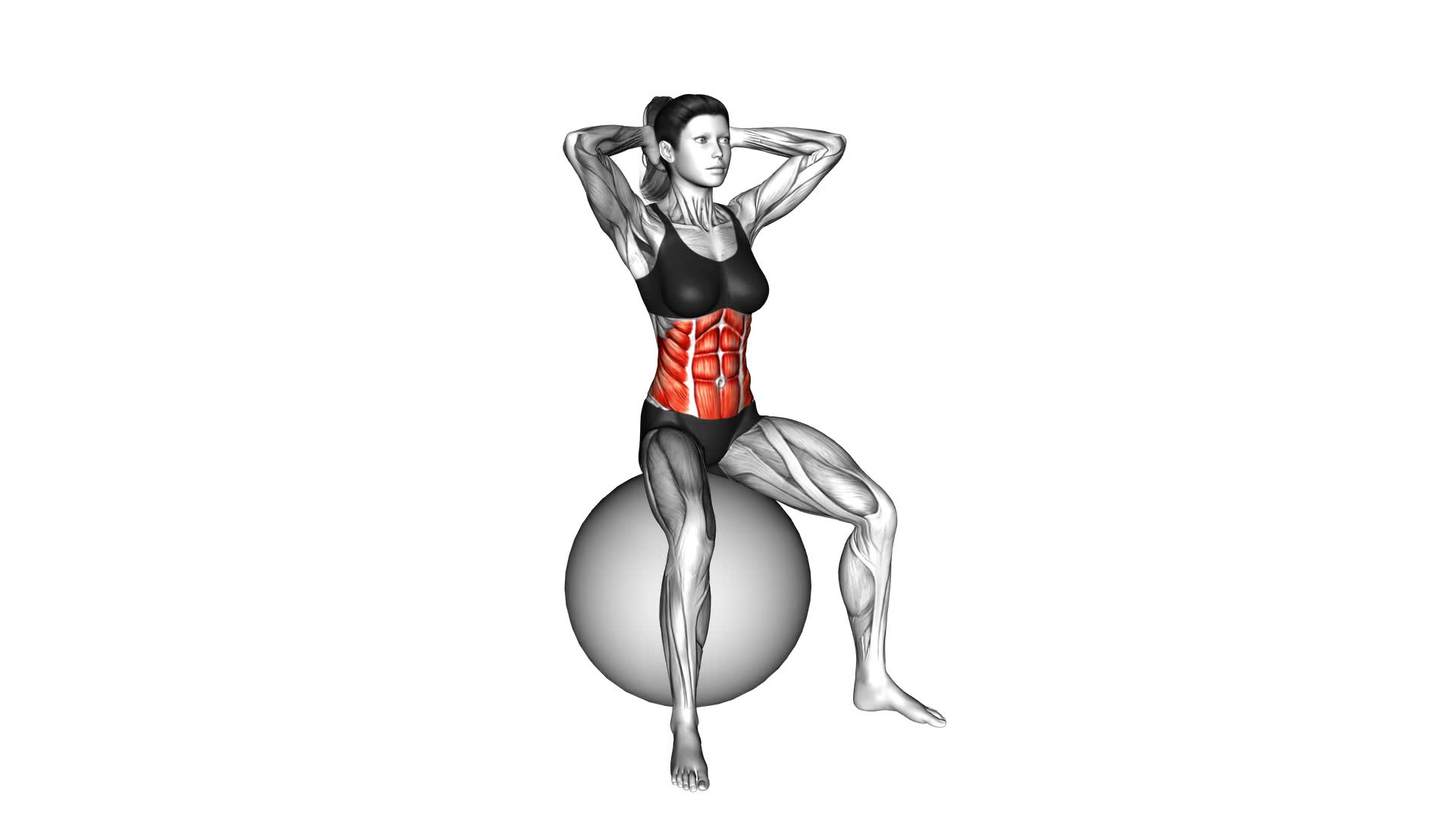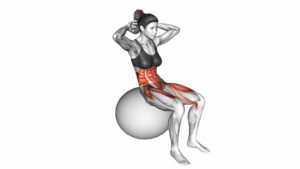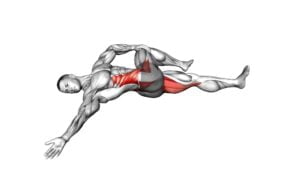Spinal Stretch (On Stability Ball) – Video Exercise Guide & Tips

Get ready to stretch and strengthen your spine with the Spinal Stretch on a Stability Ball! In this video exercise guide, you'll learn the proper form and set up for this effective move.
Watch This Exercise Video
Whether you're a beginner or advanced, there are modifications and variations to suit your fitness level. Avoid common mistakes and get the most out of your workout with these expert tips.
Let's dive in and give your spine the attention it deserves!
Key Takeaways
- Spinal stretch on a stability ball improves spinal mobility and alleviates tension in the back.
- Engaging core muscles and maintaining proper posture are essential for proper form and set up.
- Aligning the body correctly, including the feet, core, head, and neck, is important during the exercise.
- Core engagement techniques, such as focusing on breath and activating deep core muscles, enhance the effectiveness of the spinal stretch exercise.
Benefits of Spinal Stretch on Stability Ball
Spinal stretch benefits on a stability ball are numerous and can greatly contribute to your overall spinal health and flexibility. One of the key benefits is improved spinal mobility. By performing stretches on a stability ball, you're able to target specific areas of your spine and gently stretch and lengthen the muscles surrounding it. This can help to alleviate tension and tightness in the back, relieving discomfort and promoting a greater range of motion.
Another benefit is increased core strength. The unstable surface of the stability ball engages your core muscles as you perform the stretches, forcing them to work harder to maintain balance and stability. This can lead to improved core strength and stability, which is essential for maintaining proper posture and preventing back pain.
Additionally, spinal stretches on a stability ball can help to improve your posture. As you stretch and lengthen the muscles in your back, you're also improving the alignment of your spine. This can help to correct any imbalances or misalignments that may be contributing to poor posture.
In terms of technique, it's important to start with gentle stretches and gradually increase the intensity as your flexibility improves. It's also crucial to maintain proper form throughout the stretches, keeping your core engaged and your movements controlled.
Proper Form and Set Up
To ensure proper form and set up for the spinal stretch on a stability ball, there are three key points to keep in mind.
First, focus on aligning your body correctly to maintain proper posture throughout the exercise.
Second, engage your core muscles to stabilize your body and protect your spine.
Lastly, position the stability ball appropriately to provide support and maintain balance during the stretch.
Aligning Your Body
Maintain proper alignment of your body during the spinal stretch exercise on the stability ball. Correct body alignment is essential to ensure effective posture correction and prevent injury.
Here are three key points to keep in mind:
- Positioning your feet: Place your feet shoulder-width apart and firmly on the ground to provide a stable base. This will help you maintain balance and stability during the exercise.
- Engaging your core: Activate your abdominal muscles by pulling your belly button towards your spine. This will help stabilize your spine and maintain proper alignment throughout the exercise.
- Aligning your head and neck: Keep your head and neck in a neutral position, aligning them with your spine. Avoid straining or tilting your head, as this can lead to unnecessary tension and discomfort.
Core Engagement Techniques
Use three key techniques to engage your core properly for the spinal stretch exercise on the stability ball. Core activation is crucial for maintaining stability and maximizing the benefits of this exercise.
First, focus on your breath. Take deep inhales and exhales, drawing your belly button towards your spine on the exhale to engage your deep core muscles.
Second, imagine pulling your ribcage towards your pelvis, creating a slight crunching sensation in your midsection. This will activate your rectus abdominis and help stabilize your spine.
Finally, keep your glutes and pelvic floor muscles engaged throughout the exercise to provide additional support and core strengthening.
By employing these core engagement techniques, you'll enhance the effectiveness of the spinal stretch on the stability ball.
Now, let's move on to stability ball positioning.
Stability Ball Positioning
Now, let's position the stability ball for proper form and set up to ensure an effective spinal stretch exercise.
- Place the stability ball on a flat surface, ensuring it's fully inflated and can support your body weight.
- Position yourself in front of the stability ball, facing away from it.
- Sit on the stability ball and walk your feet forward, allowing the ball to roll under your back until it's positioned at your lower back.
Proper positioning of the stability ball is crucial for stability ball exercises, especially when it comes to spinal decompression. By positioning the ball at your lower back, you create a stable base and allow for a greater range of motion during the spinal stretch exercise. This helps to alleviate tension in the spine and promote spinal decompression, leading to improved flexibility and reduced back pain.
Remember to always maintain proper form and engage your core muscles throughout the exercise for maximum effectiveness.
Step-by-Step Guide to Performing the Spinal Stretch
To perform the Spinal Stretch exercise on a stability ball, start by sitting on the ball with your feet flat on the ground. Place your hands on your hips, and engage your core muscles to maintain stability. Gently lean back, allowing the ball to support your lower back. As you lean back, keep your feet firmly planted on the ground. This position will help to stretch and elongate your spine.
The Spinal Stretch exercise offers several benefits for your body. It helps to improve spinal flexibility and mobility, relieving tension and tightness in the back. By stretching the spine, you can improve your overall posture and alignment. Additionally, this exercise can help to alleviate lower back pain and improve your balance and stability.
Once you have mastered the basic Spinal Stretch exercise, you can explore advanced variations to challenge yourself further. These variations may include adding arm movements or incorporating additional core exercises to intensify the stretch and engage more muscles.
Now that you have learned the step-by-step guide for performing the Spinal Stretch exercise, let's move on to the next section, which will discuss modifications and variations for all fitness levels.
Modifications and Variations for All Fitness Levels
Now let's explore the modifications and variations that can cater to all fitness levels in the spinal stretch exercise.
Whether you're a beginner looking for easier modifications or an advanced individual seeking a challenge, there are options available to suit your needs.
Beginner-Friendly Modifications
For a beginner-friendly modification, start by using a lighter stability ball. This will allow you to ease into the exercise and gradually build up your strength and stability. Here are three additional modifications and variations that can help beginners improve their spinal flexibility:
- Use a wall for support: If balancing on the stability ball feels too challenging, you can place the ball against a wall. This will provide extra stability and support as you perform the spinal stretch.
- Modify the range of motion: Instead of fully extending your spine, start by performing smaller movements. This will help you gradually increase your range of motion over time.
- Use a smaller ball: If the standard stability ball feels too large or unstable, consider using a smaller exercise ball. This will provide a more secure base and make the exercise more accessible for beginners.
Advanced Level Variations
If you're ready to take your spinal stretch on a stability ball to the next level, there are several advanced level variations and modifications that can be made for all fitness levels.
These advanced modifications will challenge your core strength and stability even further, helping you to improve your overall fitness.
One option is to perform the spinal stretch with one leg extended in the air, which adds an extra level of difficulty to the exercise.
Another variation is to add a twist at the end of the stretch, engaging your oblique muscles and further enhancing the benefits of the exercise.
For a more advanced core workout, you can try performing the spinal stretch with a medicine ball or dumbbell held in your hands, adding extra resistance and intensity.
These advanced modifications are perfect for those looking to take their core exercises to the next level and achieve greater strength and stability.
Common Mistakes to Avoid
To avoid common mistakes while performing the spinal stretch on a stability ball, be mindful of your form and maintain proper alignment throughout the exercise. This will help you avoid injuries and maximize flexibility. Here are three key points to keep in mind:
- Maintain a stable base: Make sure your stability ball is properly inflated and positioned on a non-slip surface. This will provide a stable foundation for your exercise and prevent any unnecessary wobbling or rolling.
- Engage your core: Throughout the spinal stretch, it's important to engage your core muscles to maintain stability and control. This will help protect your lower back and prevent any strain or discomfort.
- Don't overextend: While it's important to stretch and lengthen your spine, be cautious not to overextend or hyperextend. This can put excessive pressure on your spinal discs and lead to injury. Instead, focus on maintaining a gentle and controlled stretch.
By following these guidelines, you can perform the spinal stretch on a stability ball safely and effectively.
Now, let's move on to the next section for some tips on how to get the most out of your spinal stretch.
Tips for Getting the Most Out of Your Spinal Stretch
To maximize the benefits of your spinal stretch on a stability ball, it's important to focus on proper form and engage your core muscles throughout the exercise. By following these tips, you can improve flexibility and prevent back pain.
Firstly, make sure you position yourself correctly on the stability ball. Sit on the ball with your feet flat on the floor, hip-width apart. Keep your knees bent at a 90-degree angle and maintain a neutral spine. This alignment is crucial for targeting the right muscles and avoiding unnecessary strain on your back.
As you perform the spinal stretch, be mindful of your breathing. Inhale deeply through your nose as you lengthen your spine and extend your arms overhead. Exhale slowly through your mouth as you round your upper back and bring your arms forward.
To engage your core muscles, imagine pulling your belly button towards your spine. This activation will stabilize your torso and enhance the stretch. Maintaining this engagement throughout the exercise won't only protect your back but also intensify the benefits of the stretch.
Remember to perform the spinal stretch on a stability ball regularly to see the best results. Consistency is key when it comes to improving flexibility and preventing back pain. So make it a part of your fitness routine and enjoy the benefits of a healthier spine.
Frequently Asked Questions
Can the Spinal Stretch on Stability Ball Help Improve Posture?
Yes, the spinal stretch on a stability ball can indeed help improve your posture. By engaging your core muscles and stretching your spine, this exercise promotes proper alignment and encourages you to maintain an upright position throughout the day.
Not only can it help alleviate back pain by relieving tension and pressure on the spine, but it also strengthens the muscles that support good posture. Incorporating this stretch into your routine can have a positive impact on your overall posture and well-being.
Is It Safe to Perform the Spinal Stretch on Stability Ball if You Have a History of Back Pain?
Performing the spinal stretch on a stability ball can be risky if you have a history of back pain. While the exercise can help improve posture, it may put strain on your back and exacerbate your condition.
It's important to consult with a healthcare professional before attempting this exercise. They can assess your specific situation and provide guidance on whether it's safe for you to perform the spinal stretch on a stability ball.
How Often Should the Spinal Stretch on Stability Ball Be Performed to See Results?
To see results from the spinal stretch on a stability ball, you need to perform it with the right frequency. The benefits of this exercise can be maximized by doing it regularly.
The recommended frequency for performing the spinal stretch is three to four times a week. By incorporating this exercise into your routine consistently, you can improve your spinal flexibility and strengthen the muscles in your back, leading to better posture and reduced back pain.
Can the Spinal Stretch on Stability Ball Be Used as a Warm-Up Exercise?
Yes, the Spinal Stretch on the stability ball can be used as a warm-up exercise. It helps to loosen up your spine and prepare your body for more intense workouts.
To modify the stretch, you can adjust the position of your body on the stability ball or use a smaller ball for more stability. Remember to engage your core and maintain proper form throughout the exercise.
Incorporating the Spinal Stretch into your warm-up routine can help improve flexibility and prevent injuries.
Are There Any Specific Breathing Techniques to Follow During the Spinal Stretch on Stability Ball?
During the spinal stretch on the stability ball, it's important to focus on your breathing techniques. By taking slow, deep breaths, you can enhance the stretch and promote relaxation.
Inhale deeply as you extend your spine and exhale as you relax into the stretch. Remember to modify the exercise if needed, by using a smaller stability ball or adjusting the intensity of the stretch.
Proper breathing techniques will help you get the most out of this exercise.
Conclusion
Incorporating the spinal stretch on a stability ball into your exercise routine can provide numerous benefits for your overall spinal health and flexibility.
By following the proper form and set-up, as well as utilizing modifications and variations for different fitness levels, you can maximize the effectiveness of this exercise.
Avoiding common mistakes and following expert tips will ensure you get the most out of your spinal stretch.
Start incorporating this exercise into your routine today for improved spinal health.

Author
Years ago, the spark of my life’s passion ignited in my mind the moment I stepped into the local gym for the first time. The inaugural bead of perspiration, the initial endeavor, the very first surge of endorphins, and a sense of pride that washed over me post-workout marked the beginning of my deep-seated interest in strength sports, fitness, and sports nutrition. This very curiosity blossomed rapidly into a profound fascination, propelling me to earn a Master’s degree in Physical Education from the Academy of Physical Education in Krakow, followed by a Sports Manager diploma from the Jagiellonian University. My journey of growth led me to gain more specialized qualifications, such as being a certified personal trainer with a focus on sports dietetics, a lifeguard, and an instructor for wellness and corrective gymnastics. Theoretical knowledge paired seamlessly with practical experience, reinforcing my belief that the transformation of individuals under my guidance was also a reflection of my personal growth. This belief holds true even today. Each day, I strive to push the boundaries and explore new realms. These realms gently elevate me to greater heights. The unique combination of passion for my field and the continuous quest for growth fuels my drive to break new ground.







